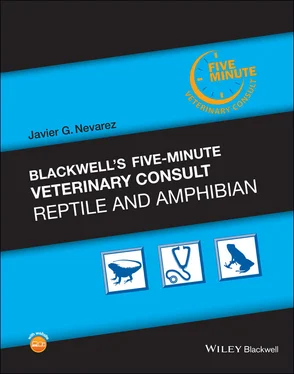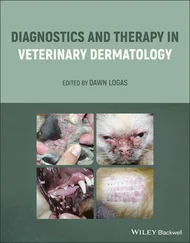Javier G. Nevarez - Blackwell's Five-Minute Veterinary Consult - Reptile and Amphibian
Здесь есть возможность читать онлайн «Javier G. Nevarez - Blackwell's Five-Minute Veterinary Consult - Reptile and Amphibian» — ознакомительный отрывок электронной книги совершенно бесплатно, а после прочтения отрывка купить полную версию. В некоторых случаях можно слушать аудио, скачать через торрент в формате fb2 и присутствует краткое содержание. Жанр: unrecognised, на английском языке. Описание произведения, (предисловие) а так же отзывы посетителей доступны на портале библиотеки ЛибКат.
- Название:Blackwell's Five-Minute Veterinary Consult: Reptile and Amphibian
- Автор:
- Жанр:
- Год:неизвестен
- ISBN:нет данных
- Рейтинг книги:4 / 5. Голосов: 1
-
Избранное:Добавить в избранное
- Отзывы:
-
Ваша оценка:
- 80
- 1
- 2
- 3
- 4
- 5
Blackwell's Five-Minute Veterinary Consult: Reptile and Amphibian: краткое содержание, описание и аннотация
Предлагаем к чтению аннотацию, описание, краткое содержание или предисловие (зависит от того, что написал сам автор книги «Blackwell's Five-Minute Veterinary Consult: Reptile and Amphibian»). Если вы не нашли необходимую информацию о книге — напишите в комментариях, мы постараемся отыскать её.
STAY UP TO DATE ON THE BEST PRACTICES FOR TREATING COMMON DISEASES IN REPTILES AND AMPHIBIANS Blackwell’s Five-Minute Veterinary Consult: Reptile and Amphibian
Blackwell’s Five-Minute Veterinary Consult: Reptile and Amphibian
Blackwell's Five-Minute Veterinary Consult: Reptile and Amphibian — читать онлайн ознакомительный отрывок
Ниже представлен текст книги, разбитый по страницам. Система сохранения места последней прочитанной страницы, позволяет с удобством читать онлайн бесплатно книгу «Blackwell's Five-Minute Veterinary Consult: Reptile and Amphibian», без необходимости каждый раз заново искать на чём Вы остановились. Поставьте закладку, и сможете в любой момент перейти на страницу, на которой закончили чтение.
Интервал:
Закладка:
LIVER
Liver anatomy varies among amphibian species. Anurans have a more traditional bilobed liver while in Caudates and Caecilians it is elongated and marginated. The gall bladder is usually well developed and intimately associated with the liver. A bile duct connects to the duodenum or pancreatic duct in some species. The liver is a significant erythropoietic center and also contributes to leukocyte production during metamorphosis. A large amount of pigmented melanomacrophages and non‐pigmented Kupffer cells can be found and contribute to immune function. The amount of these cells present at any given time is influenced by seasonality. They also increase in numbers with age and antigenic stimulation. Melanomacrophages are commonly identified in aspirates of animals with coelomitis.
URINARY SYSTEM
Amphibians have mesonephric kidneys that cannot concentrated urine above plasma osmolality. A single or bilobed urinary bladder is present in most species. Larvae and aquatic species are primarily ammoniotelic while terrestrial species are primarily ureotelic. There is a lesser number of primary uricotelic species (waxy tree frogs). Clawed frogs have the ability to be ammoniotelic or ureotelic depending on water availability.
REPRODUCTION
Amphibians have paired gonads consisting of either testes – Wolffian duct – cloaca, or ovaries – coelom – infundibulum – oviduct.
The Bidder’s organ is a remnant of ovarian tissue in male bufonid frogs and does not indicate hermaphroditism. Salamanders have internal fertilization but lack an intromittent organ. Instead, sperm packets are deposited on the environment to be picked up by the female. The exceptions are the Asiatic salamanders and giant salamander, which deposit sperm on egg masses. Caecilians have internal copulation and fertilization with a phallodeum for intromission and 75% are viviparous.
Examples of sexual dimorphism:
bullfrogs—males have large tympanic membranes
White’s tree frogs—males have nuptial pads during breeding season
dyeing arrow frogs—males have large triangular toes, females have small, round toes
red‐eyed tree frogs—males are smaller.
NERVOUS SYSTEM
The spinal cord in anurans ends in the lumbar vertebrae and a cauda equina is present. In caecilians and salamanders, the spinal cord extends to the tip of the tail. A lateral line similar to that in fish is present in larvae and aquatic species.
UVB Lighting Principles for Captive Amphibians
Exposure to ultraviolet B (UVB) light is a critical aspect of reptile husbandry, but there is less information available about its requirement for amphibian species. As in reptiles, UVB and/or calcium deficiencies are suspected to contribute to the development of nutritional secondary hyperparathyroidism in amphibians. However, it is more difficult to make specific recommendations on UVB use in amphibians due to the lack of information on this subject. Some background information and general guidelines are provided here to assist in the decision‐making process when selecting UVB sources for amphibians.
UVB LIGHT AND VITAMIN D3
Ultraviolet light (UV) is electromagnetic radiation that exists in three main bands: UVA, UVB, and UVC. Each band is characterized by a specific wavelength. UVA has the longest wavelength at 320–400 nm while UVB has a wavelength of 290–320 nm. Both UVA and UVB have low tissue penetration with most being absorbed at the epidermis. UVA has a wavelength of less than 290 nm, the deepest penetration, and is the most harmful. These wavelengths place ultraviolet somewhere between visible light (369–769 nm) and x‐rays (0.01–10 nm). The ozone layer is responsible for filtering the majority of ultraviolet radiation hence protecting living organisms from its harmful exposure. UVC is considered germicidal and can have significant harmful effects to living animals while both UVA and UVB have therapeutic and physiologic applications. Still, as we know from human medicine, too much sun/ultraviolet exposure, has a slew of negative implications ranging from sunburn to premature aging, and cancer.
UVB light is essential for the synthesis of vitamin D3. Although commonly referred to as a vitamin, D3 is actually a hormone. UVB light from the sun stimulates conversion of 7‐dehydrocholesterol to cholecalciferol (D3) in the skin. Cholecalciferol is then transported to the liver via the blood stream and hydroxylated into 25‐hydroxycholecalciferol (calcidiol), which is then transported to the kidneys for hydroxylation into 1,25‐dihydroxycholecalciferol (calcitriol), the active form of D3. The 25‐hydroxycholecalciferol in the liver is the storage form of D3 and is a natural source of D3 for animals fed whole prey. Plants are a source of ergocalciferol or ergosterol (D2), which is not readily bioavailable to most animals and is therefore not an appropriate source of D3 supplementation. Calcidiol, an animal source of D3, is more bioavailable for most animal species, and is suspected to be the same for amphibians.
There are two main sources of UVB, natural sunlight and UVB bulbs. Exposure to natural sunlight is likely the most efficient way for amphibians to synthesize adequate levels of D3. However, there is a high degree of variability in the lifestyle of amphibians from cryptic species that barely get sunlight exposure to those that may display basking behaviors similar to reptiles. This variability makes it nearly impossible to provide blanket recommendations for UVB supplementation for amphibians. Instead, we must rely on knowledge of the natural behaviors of the species, their geographical location, and expected UVB exposures at that location to make extrapolations about the use of UVB light supplementation in captivity. One thing that most can agree on is the fact that amphibians should be exposed to lower levels of UVB than reptiles.
CHOOSING UVB LIGHTING
UVB bulbs can be divided into linear fluorescent, compact fluorescents, and mercury vapor. In the future, commercial LED UVB lights may also become available. Fluorescent UVB bulbs provide light in the required wavelength for D3 synthesis, but no heat. Mercury vapor bulbs provide both heat and UVB. Mercury vapor bulbs can provide very high levels of UVB exposure and their use should be avoided in amphibians. There are six main aspects to consider when selecting a UVB bulb:
1 Size/type of the enclosure.
2 Type of material between the bulb and the reptile.
3 Type of bulb.
4 Effective distance of the bulb.
5 Bulb longevity.
6 Species of amphibian.
Another consideration is the type of fixture used for the bulb. There are a number of fixtures that offer the advantage of having reflective materials to increase light reflection and decrease scattered light emission (radiation). Reptile/amphibian‐specific light fixtures or those that reflect light away from the bulb and towards the animal are preferred over plastic fixtures or those without reflective properties.
T8 Linear Fluorescent Tubes
The T8 bulbs (25‐mm or 1‐inch diameter) are available in different lengths and fit into standard aquarium or reptile hoods. Some manufacturers further classify their bulbs by a number system ranging from 2.0 to 10.0. This number represents the percentage of light that is emitted in the UVB spectrum. A 5.0 has 5% of the emitted light in the UVB spectrum, a 10.0 has 10% UVB emission, and so on. Arcadia® has simplified the process by simply stating the percentage of UVB emission with their bulbs ranging from 6% to 14%. For amphibians, bulbs emitting less than 5% UVB are likely the best option to avoid the possibility of overexposure.
Читать дальшеИнтервал:
Закладка:
Похожие книги на «Blackwell's Five-Minute Veterinary Consult: Reptile and Amphibian»
Представляем Вашему вниманию похожие книги на «Blackwell's Five-Minute Veterinary Consult: Reptile and Amphibian» списком для выбора. Мы отобрали схожую по названию и смыслу литературу в надежде предоставить читателям больше вариантов отыскать новые, интересные, ещё непрочитанные произведения.
Обсуждение, отзывы о книге «Blackwell's Five-Minute Veterinary Consult: Reptile and Amphibian» и просто собственные мнения читателей. Оставьте ваши комментарии, напишите, что Вы думаете о произведении, его смысле или главных героях. Укажите что конкретно понравилось, а что нет, и почему Вы так считаете.












